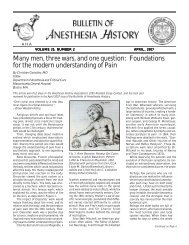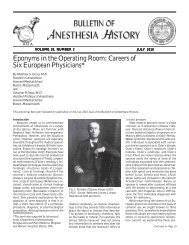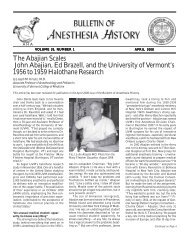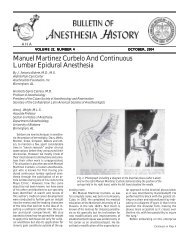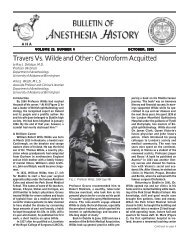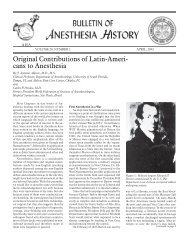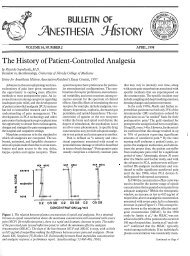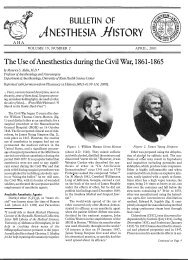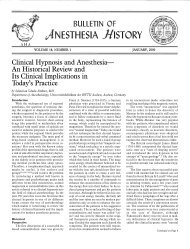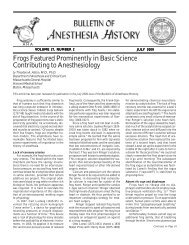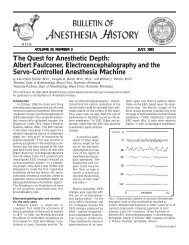January 2006, Vol 24 - Anesthesia History Association
January 2006, Vol 24 - Anesthesia History Association
January 2006, Vol 24 - Anesthesia History Association
You also want an ePaper? Increase the reach of your titles
YUMPU automatically turns print PDFs into web optimized ePapers that Google loves.
Book Reviews<br />
by Ray J. Defalque, M.D.<br />
Professor {Retired}<br />
Department of Anesthesiology<br />
University of Alabama at Birmingham<br />
Cousin, Marie Therese. L’Anesthesie-<br />
Reanimatino en France. Des Origines a<br />
1965. <strong>Vol</strong>ume 1. Anesthesie. <strong>Vol</strong>ume 2. Reanimation.<br />
Les Nouveaux Professionels.<br />
Paris, L’Harmattan Editions, 2005, 680<br />
pages, 63 Euros.<br />
Professor Marie Therese Cousin, retired<br />
Chief of <strong>Anesthesia</strong> at the Broussais Hospital<br />
of Paris, has just published a twovolume<br />
(680 pages) history of anesthesia<br />
and intensive care in France from their<br />
beginnings to 1965. This original work,<br />
richly documented and illustrated and with<br />
a wealth of references, is the product of the<br />
author’s years of research at the Sorbonne<br />
and her experience as a clinician. It is the<br />
first encyclopedic history of French anesthesia<br />
in all its aspects. Dr. Cousin points<br />
out that although many anesthetic discoveries<br />
originated outside of her country, the<br />
French physicians and scientists immediately<br />
understood their significance,<br />
adopted them and contributed important<br />
modifications and additions.<br />
<strong>Vol</strong>ume 1 briefly describes the contributions<br />
of the French chemists, physicists and<br />
physiologists before 1846. The following<br />
chapters address each inhalation agent<br />
(from ether to halothane), the intravenous<br />
anesthetics, the local and regional techniques<br />
and drugs and the muscle relaxants<br />
BULLETIN OF ANESTHESIA HISTORY 11<br />
(including Daniel Bovet’s great contributions).<br />
The last chapters narrate the birth<br />
of pediatric and obstetric anesthesia in<br />
France.<br />
<strong>Vol</strong>ume 2 reviews the history of resuscitation<br />
in Europe before the arrival of anesthesia<br />
(a fascinating, largely unknown<br />
topic), the introduction of intensive care<br />
on the Continent after WW2 (with the engrossing<br />
history of the 1952 epidemic of<br />
poliomyelitis in Denmark) and the ventilators<br />
and monitors used in France since<br />
that time. Several chapters on the struggle<br />
to create anesthesia as an independent specialty<br />
in France with its political and financial<br />
aspects and others on the birth of<br />
the French professional societies, journals<br />
and teaching programs will be of less relevance<br />
to the foreign anesthetist. Interesting,<br />
however, is how modern anesthesia was<br />
introduced in France after WW2 by young<br />
physicians who had fled their occupied<br />
country and learned their trade while serving<br />
in the British and, especially, the US<br />
armed forces during the war. Also the<br />
struggle to obtain professional recognition<br />
and financial independence in France is a<br />
good mirror of the professional battles on<br />
the Continent after WW2. The US anesthesiologists<br />
were fortunately spared those<br />
trying times.<br />
Dr. Cousin’s work is extensively researched<br />
and her topics presented in great<br />
details and supported by an abundance of<br />
references. References and notations are<br />
conveniently placed at the bottom of each<br />
page, thus sparing the reader continuous<br />
and tedious to-and-fro reading between the<br />
text and the end of each chapter. <strong>Vol</strong>ume 2<br />
has two very inclusive indexes, one for the<br />
names and another for the topics. Professor<br />
Cousin writes with enormous enthusiasm<br />
in a most elegant, clear and concise<br />
French. She solves some medico-historical<br />
mysteries and occasionally adds witty,<br />
even sly, personal comments. Although a<br />
rigorously scientific work, the book reads<br />
like a novel, or what the French call a “livre<br />
de chevet” (bedside book).<br />
There is a wealth of pictures of equipment<br />
and photographs of French physicians<br />
and scientists rarely published in<br />
anesthesia textbooks. Some of the photographs,<br />
unfortunately are of poor quality.<br />
I hope that this unique contribution to the<br />
history of our specialty will be re-published<br />
in a hardback edition on good paper and<br />
with better photographs. I also hope that<br />
Dr. Cousin’s books will be translated into<br />
English for the education and enjoyment<br />
of foreign anesthesiologists. This important<br />
work deserves a large, world-wide audience.<br />
Cazalaa JB, Baker D, Cousin MT. Les Instruments<br />
d’Anesthesie et de Reanimation.<br />
Apparatus for Anaesthesia and Intensive<br />
Care. Paris, Glyphe Editions, 2005, 156<br />
pages, 45 Euros.<br />
Dr. Cazalaa, Professor of <strong>Anesthesia</strong> at<br />
the Necker Hospital of Paris, has just published<br />
a masterpiece bound to seduce all<br />
historians of anesthesia. Dr. Cazalaal’s bilingual<br />
book presents a collection of over<br />
150 European inhalers and anesthesia-related<br />
equipment (1847-1970) gathered in<br />
Paris for the 2004 World Congress of <strong>Anesthesia</strong>.<br />
Each object is handsomely photographed<br />
in vivid colors and its history,<br />
development and use briefly described. Dr.<br />
Camalaa’s graceful French text has been<br />
elegantly translated in English by Dr.<br />
Baker.<br />
This original, truly magnificent piece<br />
of art, written with love by an enthusiastic<br />
historian of anesthesia and published at a<br />
very affordable price ($50.00) deserves a<br />
place in the library of all anesthesiologists<br />
interested in the historv of our specialty.<br />
I hope that Professor Cazalaa and his<br />
team will continue their search for, and<br />
study of, other anesthetic equipment scattered<br />
throughout the world and soon will<br />
spoil us with an extensive addition to this<br />
superb book.<br />
Dr. Cazalaa’s book may be purchased<br />
on the web at order@editions-glyphe.com<br />
(prepayment by Paypal) or from the Wood<br />
Library-Museum.



